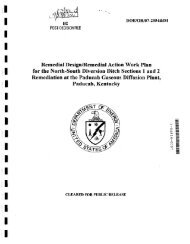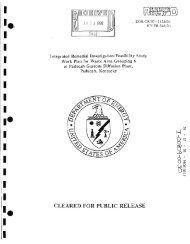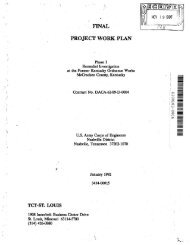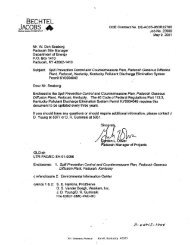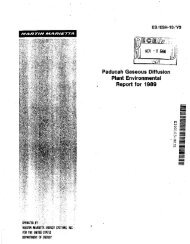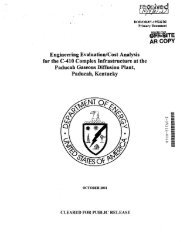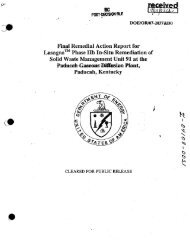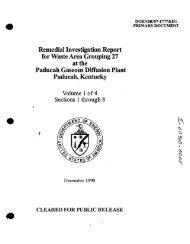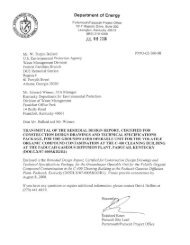1 - paducah environmental information center
1 - paducah environmental information center
1 - paducah environmental information center
You also want an ePaper? Increase the reach of your titles
YUMPU automatically turns print PDFs into web optimized ePapers that Google loves.
Paducah Site<br />
B.1.2 DESCRiPtiON OF DATA SET<br />
The data set used for this plume map<br />
revision contains groundwater data from two<br />
types of sample locations: monitoring wells<br />
whose· screen mid-point is between elevations<br />
76.2 m (250 ft) and 97.5 m (320 ft) above mean<br />
sea level, and temporary borings in which a<br />
groundwater sample was collected from<br />
between the same two elevations. Only those<br />
wells and borings for which location coordinates,<br />
surface elevations, and screen or sample depths<br />
were available were included in the data set. As<br />
a result data from the following projects are not<br />
included in this interpretation:<br />
• monitoring wells belonging to the<br />
Tennessee Valley Authority's Shawnee<br />
Steam Plant,<br />
• residential water wells within the study<br />
area,<br />
• temporary borings from the WAG 22 RI,<br />
• temporary borings from the Northeast<br />
Plume Interim Remedial Action, and<br />
• temporary borings from the WAG 3 RI.<br />
This <strong>information</strong> is currently being<br />
gathered and will be included in the next revision<br />
as appropriate.<br />
B.1.3 SELECTION OF DATA POINTS<br />
To identify those wells and borings<br />
which fit the depth criteria, the OREIS database<br />
was queried for all water samples analyzed for<br />
TCE, 99Tc, or beta activity. The sample interval<br />
for each collected sample was converted to<br />
elevation and filtered to exclude those samples<br />
outside the elevations used to define the RGA.<br />
For monitoring wells, the elevation of the midpoint<br />
of the well screen was used as the sample<br />
depth. The samples were then segregated into<br />
lower, middle, and upper RGA intervals, defined<br />
as elevations 76.2 to 89.9 m (250 to 295 ft), 89.9<br />
to 93.0 m (295 to 305 ft), and 93.0 to 97.5 m (305<br />
to 320 ft) above mean sea level, respectively.<br />
The interval for the lower RGA is larger than the<br />
upper or middle so that data from "channels"<br />
identified in various portions of the plant would<br />
be included in the interpretation. Once the<br />
sample points were assigned to one of the three<br />
intervals, base maps for each interval that<br />
showed only those wells and borings that<br />
collected a sample from that interval were<br />
printed.<br />
B.1.4 SELECTION OF GROUNDWATER<br />
DATA<br />
The groundwater data set consists of<br />
TCE concentrations, 99Tc activities, or beta<br />
activities for those data points defined as RGA in<br />
this report. The data were selected from all<br />
groundwater data collected on or before<br />
December 31, 1999, and entered in OREIS by<br />
March 1, 2000. For monitoring well data, time<br />
versus concentration plots were created and<br />
trend lines developed. To normalize the data,<br />
these trend lines were used to determine the<br />
probable concentration of the well as of June 30,<br />
1999. This value was then plotted on the base<br />
maps. For temporary borings, the actual<br />
analytical value was used. For borings with<br />
multiple samples within one interval, the highest<br />
concentration within the interval waS selected<br />
and plotted on the base maps. Data from CY<br />
1999 were given the highest priority, while data<br />
from earlier years were used in trending and<br />
identifying approximate boundaries with the<br />
oldest data being of least value in the<br />
interpretation.<br />
B.1.5 MAPPING OF DATA.<br />
After all data were plotted on the base<br />
maps, the data were hand-contoured. Separate<br />
maps were made for both TCE and 99Tc in the<br />
upper, middle and lower RGA intervals. The<br />
contour intervals for TCE and 99Tc were as<br />
follows:<br />
0-10<br />
Appendix 0



